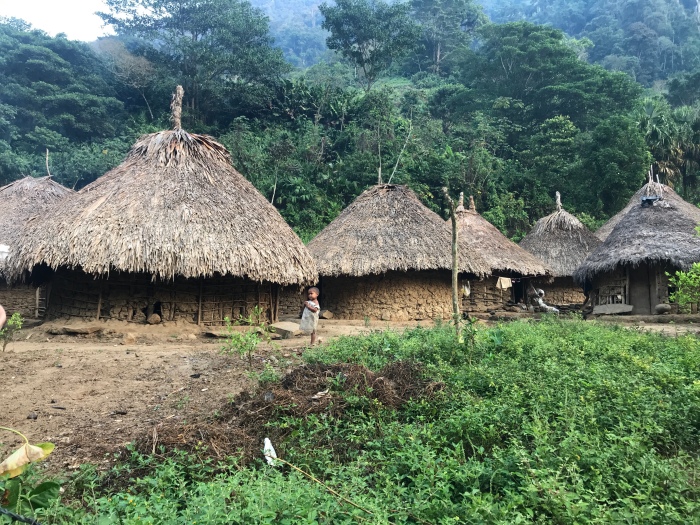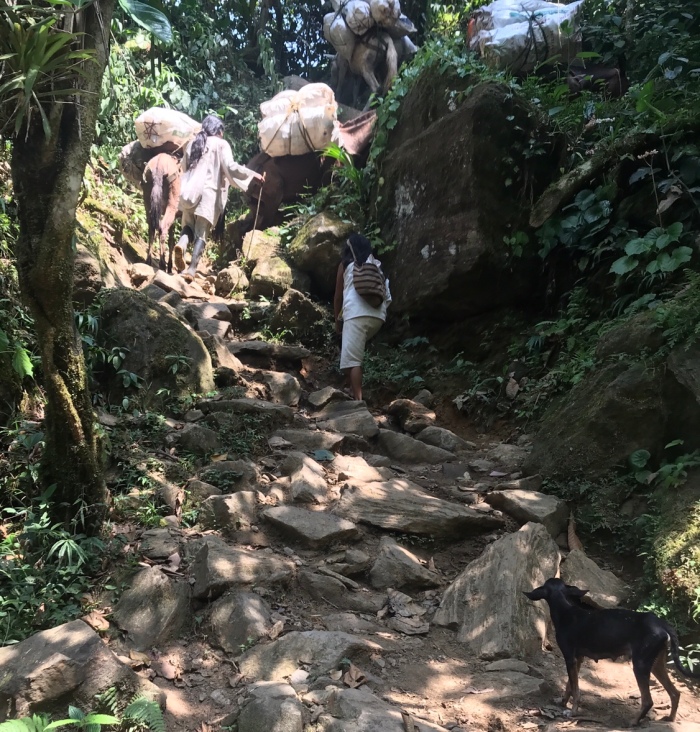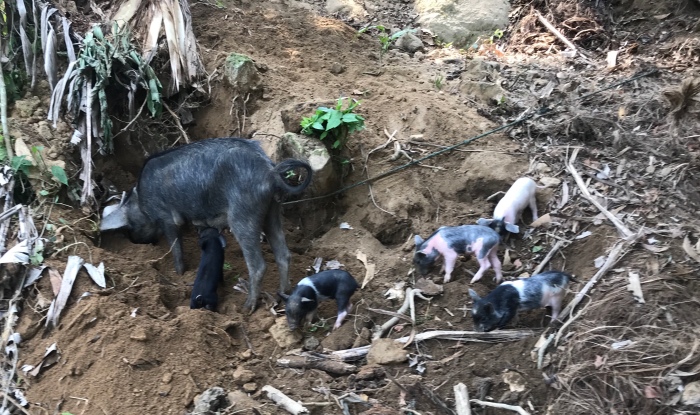Expect The Bizarre
At orientation, Felipe mentioned that we should “expect the bizarre.” Must admit, I was intrigued by that. A few times that day I found myself singing along with ORC in my head “How bizarre, how bizarre . . . ” https://www.youtube.com/watch?v=oGUMsxVt4YU
 The roosters woke me at 4 a.m. Crowing solo, crowing in stereo, crowing to each other, crowing a capella. Why in the world do roosters feel the need to crow at 4 a.m.? Seriously! Shortly thereafter, the cooks began breakfast preparations which was a good thing as I was hungry, despite a generous meal of rice, smashed plantains, salad and chicken the night before.
The roosters woke me at 4 a.m. Crowing solo, crowing in stereo, crowing to each other, crowing a capella. Why in the world do roosters feel the need to crow at 4 a.m.? Seriously! Shortly thereafter, the cooks began breakfast preparations which was a good thing as I was hungry, despite a generous meal of rice, smashed plantains, salad and chicken the night before.
We were out of our beds at 5 a.m. for a 5:30 a.m. breakfast and by 6, heading for the trail (and they call this vacation . . . well, more like “adventure!”). Today would be a shorter day and the early departure meant we escaped some of the mid-day heat. While we had only 10 km (6 miles), it was tough. At one point I was again walking on my own and there was a gap between the hikers in front of me and those behind. I am going down the trail and then . . . I couldn’t figure out where the trail was. There were just huge boulders piled around me, and the Buritaca River down the bank to my left. I paused as I searched for the trail, concerned that I had somehow meandered off the route. I decided to backtrack to find the obvious trail to ensure I wasn’t lost – and once found, turned around to continue the trek. As I walked I searched for shoe prints of other hikers; here and there I could find them, and I quickly ended up right back at the piles of boulders. So THIS was the trail. Yes, it was bizarre, that they called this a trail. Up and over I went, crawling on my hands and knees with my poles dangling behind me, trying not to think about the fact that one misstep could cause me to fall down the cliff and into the river on my left. But I kept going and in time, the boulders turned into just big rocks and an obvious trail appeared again. But it was a bit harrowing.
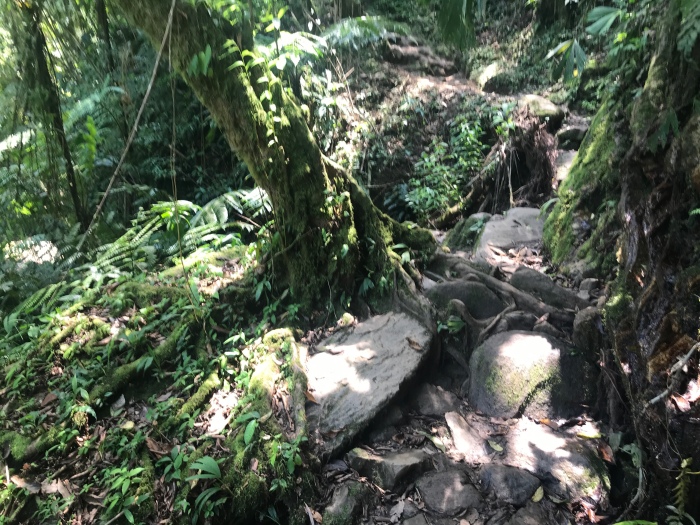
It’s funny how fast your mind can go in those situations. I began running through what I had in my pack in the event I had to spend the night in the jungle alone. I remembered the whistle that I had thrown in, thinking as I packed it that it was silly to bring it along. But I was back on track and no need to worry about such things. How often in life though don’t we go “there” . . . thinking of the worst that never happens.
We quickly discovered that most meals were a combo of rice or pasta, chicken or fish, a salad, often smashed plantains, rounded out with a glass of fresh squeezed juice. There was usually a sweet treat to finish out our meal – quite often with a bit of chocolate. Seriously, after all that trekking, we deserved every morsel of chocolate we could get! While the food was local and wholesome, it was designed to serve a bunch of people quickly, and this is likely not the tour for a foodie.
Mid morning we passed a Kogi Village; see section below for more info on that. I continue to be so fascinated with the cultures of the indigenous tribes!
Throughout the trek there were two items that were absolute necessities: water, and toilet paper. When you’re out on the trail and dumping out sweat it is hard to stay ahead of it and you simply can’t drink enough water. I have a two liter water reservoir/bladder in my backpack and would fill it at every stop. There is a hose/straw attached to this which allows you to drink hands free while you’re walking, and I always manage to get more water down this way. We had rest stops periodically and there were always large containers of purified water available. At some stops fresh fruit (super good pineapple and delicious watermelon) were provided. Also want to add that most North Americans aren’t able to tolerate Colombia water that is not purified. Of course you can drink it, but . . . well, you’ll likely get the belly button down disease.
And then toilet paper. In Colombia, toilet paper is typically not provided (not even in the airports!) and thus you need to carry your own. It also isn’t flushed as doing so clogs the plumbing. So having a supply with you is a big deal.
First, let me say there are no pics pertaining to this paragraph. There are times when you’re out on the trail that you just nature pee. Sometimes it’s a matter of necessity, other times it’s just convenience. At one stop I was in a long slow moving line to use the toilet and became impatient. I decided to slip out into the trees instead; another woman who had the same idea was emerging and she pointed me toward a canopy of leaves on a gentle downward slope. I ventured there, got into position (gals, you know the drill), dropped my shorts to my knees, and squatted, all the while surreptitiously peering behind me to ensure I didn’t have an audience. I finish and attempt to stand up. I can’t. I had forgotten to take my pack off and it was dragging me down (keep in mind I had just refilled my water reservoir, which added another five pounds). I try again, mustering up every little muscle fiber in my exhausted quads to try to bring me to a standing position. No luck. I grab at surrounding brush and try again. It just slides through my hands. So there I squat, pants at my knees and unable to stand up. I envision myself tumbling down the slope and “they” find me, lying at the bottom, my white butt cheeks shining like a beacon with my shorts bunched around my knees. Ughhh. I decide to try inching backward, right foot, left foot, scooching across the ground till I reach a level spot. Slowly, as though I am in slow motion, I pull myself to a standing position and tug my shorts up. In retrospect, I should have just unbuckled my pack, dropped it and stood up! That would have made so much more sense! But it’s a great story!
Here are a few pics of the trail, which was ever changing, awesome, and . . . challenging. I found I would go for hours breathing hard, my heart pounding. Again, the temps were in the mid-nineties which didn’t help. The inclines were tough, going downhill was tough.
Throughout the trek we had a number of water crossings. Some were actual river crossing where we took our shoes off and were mid-calf in water; others we just plowed though, others we attempted to balance as we stepped carefully from rock/boulder to rock/boulder. And then we had the occasional bridge.
My trekking poles became my third and fourth legs; I depended upon them the entire trek and was so in awe of those who could just pop up a ledge or over a rock without poles to pull them. And also those who just sauntered along, never seeming to strain or trip or fumble. That was not me; I needed all the help I could get to both keep from falling and to pull and push.
For me, every step was calculated; I was constantly looking down, making a decision about what step will be the most efficient, and which would be the safest. Should I go left which is a bit longer but no huge rocks or ledges, or right which is very direct and short but there are a number of rocks and steps up or down? Will I slip if I step there? Will I be able to even “make” that step; are my quads strong enough? All the while, I try so hard to not lose sight of everything around that is so incredibly beautiful. With 96,000 steps in this trek, that’s a lot of decisions!
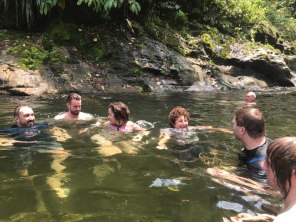 We made it into camp around 1 p.m. What a great afternoon we had; rather than heading into the showers we jumped into the nearby crystal clear (and ice cold!) Buritaca River for our showers and laundry. Yes, this is how you shower and do laundry on The Lost City trek. Seriously, the water is likely purer than what most of us have in our homes . . . albeit a bit cooler. So much fun!
We made it into camp around 1 p.m. What a great afternoon we had; rather than heading into the showers we jumped into the nearby crystal clear (and ice cold!) Buritaca River for our showers and laundry. Yes, this is how you shower and do laundry on The Lost City trek. Seriously, the water is likely purer than what most of us have in our homes . . . albeit a bit cooler. So much fun!
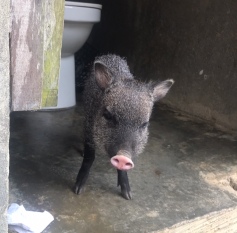 When you least expect the bizarre, it happens. So I head into the toilet . . . there is a bank of three, each with a door with an open bottom. I’m sitting on the john like all people do and I feel something against my ankles. I look down and there is a pig. Yes, there is a long haired gray pig in the stall with me. He heads for the open trash can. Ugh. Now I know why this pig is there. He really IS a pig, rooting through people’s used toilet paper. He left my stall and headed for the next . . . Felipe told me the next day that he wasn’t just your run of the mill pig, but a unique kind (I forget the name).
When you least expect the bizarre, it happens. So I head into the toilet . . . there is a bank of three, each with a door with an open bottom. I’m sitting on the john like all people do and I feel something against my ankles. I look down and there is a pig. Yes, there is a long haired gray pig in the stall with me. He heads for the open trash can. Ugh. Now I know why this pig is there. He really IS a pig, rooting through people’s used toilet paper. He left my stall and headed for the next . . . Felipe told me the next day that he wasn’t just your run of the mill pig, but a unique kind (I forget the name).
That night, I slept in a hammock. A hammock with a mosquito net. One of about ten hammocks in a bank, all strung out close to each other. You roll over or stick your butt out too far and you’re going to bump the sleeper next to you; it’s really a funny thing. I kept imagining that we were like the stainless steel collision balls that people keep on their desks . . . bump one and it bumps the next and the next. We discussed hammock sleeping tactics, how to lie, getting in and out . . . who knew it could be so complicated?! Anyway, I was able to get a few good hours of sleep and had a very entertaining dream. I dreamed I adopted The Pig. Yes, I adopted him and took him home. Had all my friends over to meet him. The Pig was house trained. And no, I did not allow The Pig to play in the bathroom.
What a full, full day on the trek to The Lost City.
The Kogi People
There are four indigenous tribes in this region; we were exposed to two of these tribes, the Kogi (hard g, pronounced Ko-gee), and the Wiwa. The Kogi are the most untouched by the modern world and they shun the influence of outside society. We passed by a Kogi village on Tuesday morning. About 45 families live here, although most don’t truly “live” here, as they are farmers and they spend the majority of their time on their farms in the mountains. They will return here once a month for a meeting with their tribe, the men meeting together for their issues in the ceremonial house, and the women meeting to discuss theirs, for maybe four or five days. They bring their belongings with them, which may include a couple of pigs, some tools for farming, and their bag with all their earthly possessions. They have very few material things.
The Kogi base their lifestyles on their belief in The Great Mother, their creator figure, who they believe is the force behind nature. As I understand it, The Great Mother is the equivalent of their God (they have but one god). Their focus on more on their spiritual development than physical. When death occurs, it is celebrated as a “fulfillment of life.”
Every village has a “Mama” (pronounced ma-moo) who is the spiritual and political leader as well as the healer of the village. A Mama is generally chosen while still in the womb and is always male. He will spend the first nine – and ideally eighteen years of his life in a cave, never exposed to daylight, only leaving the cave after dark. He is also not exposed to females during this time. The ruling Mama and other male tribesmen serve as his teachers during these years, passing down the teachings, wisdom, and knowledge of the Kogi since the beginning of time. A Kogi Mama always has two Kogi apprentices.
The average lifespan of the Kogi is around 45 years old. Forty percent of children die before they are five years old, at birth, or from accidents, bites, or diseases. My heart breaks for the Kogi mothers. Babies are typically delivered by the Mama’s wife. There is no typical number of children in a family, although I did gather that the Kogi are quite familiar with a woman’s reproductive cycle. I think it’s also important to note that there is no violence against women, and I don’t believe violence period in the Kogi society.
All Kogi wear a white gown, as you can see from the children in the photos. I took these photos in passing but they really are taboo; the Kogi are shy people and prefer to not have their photos taken. Children all wear the same gown, other than girls may have a lace braid or necklace around the neckline. When a girl reaches puberty her gown changes slightly (I don’t recall the specifics on this though). When a boy is declared a man (an adult) he begins to wear pants.
Women carry their babies in a white sling on their front. Babies don’t wear diapers but instead, the mother periodically removes the baby from the sling/basket and washes the baby and the carrier in the river.
When women have their periods (yes, we women were all curious about this) they stay inside and sit on leaves to absorb the blood, occasionally leaving to wash in the river. I have gathered that the Kogi people don’t wear underwear, although I didn’t specifically ask about this.
The Kogi men all have long hair and grow little to no facial hair. All were short in stature. When a boy becomes an adult he receives a poporo, a small, hollow gourd that is filled with “lima,” a type of powder that is made by heating and crushing shells to produce lime. The men continuously chew coca leaves, a tradition followed by many indigenous tribes to connect them to the natural world. As they chew the coca leaves, they suck on the lime powder in their poporos, which they extract with a stick, and rub the mixture on the gourd with the stick to form a hardened layer or crust. The size of this layer depends on the maturity and the age of the Kogi man.
There is so much to be learned about the Kogi culture; I feel as though we just touched the tip of the iceberg.
